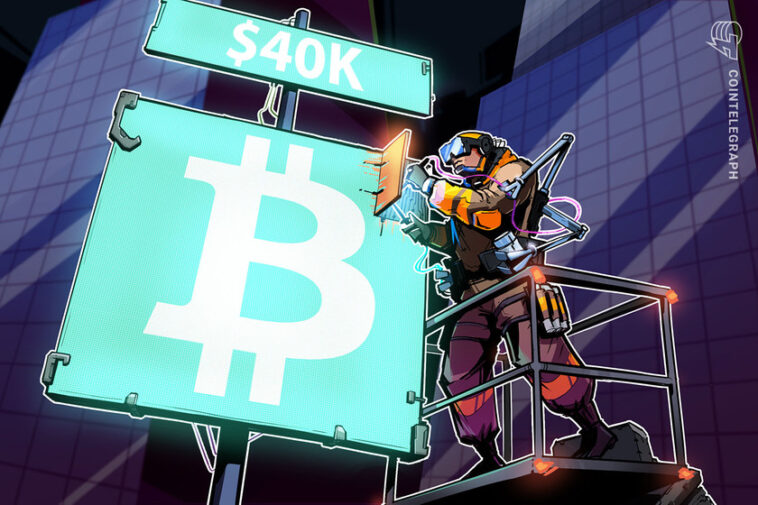The Federal Reserve Chairman had to explain what he meant by the term “transitory” inflation as he admitted that consumer prices have gone higher than he and other central bank officials had anticipated.
Bitcoin (BTC) rose above $40,000 on Thursday, a day after the Federal Reserve hinted that it was getting nearer to unwind its asset purchasing program that has boosted the United States’ economic recovery.
The benchmark cryptocurrency approached $41,000 in the previous session, ahead of the critical Fed update. Nonetheless, it started losing upside momentum after the Federal Open Market Committee (FOMC) released its policy statement, followed by a press conference helmed by the Fed chairman Jerome Powell.
As economists had expected, Fed officials left their monetary policy unchanged at the end of their two-day policy meeting. They noted that the U.S. economy has advanced higher towards its maximum employment and inflation goals and that the Fed would continue to evaluate its stimulus policy in the coming months.
Bitcoin investors have been closely monitoring how soon the central bank might unwind its $120 billion per month bond-buying program. That is partly because of the benchmark cryptocurrency’s $4,000 to 65,000 bull run against the Fed’s loose monetary policies.
To inflation or not to inflation?
Powell had earlier said that their asset purchases would continue until they see “substantial further progress” in the U.S. economic recovery.
But Wednesday’s presser was the first time Fed had to explain how it perceives “substantial further progress.” CNBC’s Steve Liesman put the said question before Powell, to which he responded that it means strong labor numbers and progress toward maximum employment.
Follow-up questions by reporters stressed Powell into explaining “transitory,” a term he and his office has repeatedly used in their previous FOMC statements to sideline concerns about the rising inflation in the U.S. Powell took at least two minutes to address the sudden line of inquiry, noting that inflation will rise short-term, but it won’t rise year-over-year.
“The [consumer price] increases will happen. We’re not saying they will reverse. So there will be inflation but [its] process will stop […] If it doesn’t effect longer-term inflation expectations then its very likely not to impact the process of inflation going forward. What I mean by transitory is that it does not leave a permanent mark on inflation process.”
Scott Skyrm, executive vice president in fixed income and Repo at Curvature Securities, noted that the FOMC statement mentioned the term “inflation” or “price stability” ten times. That showed that rising consumer prices are in the back of their mind, even though they refute its presence by resorting to the word “transitory.”
Lyn Alden, the founder of Lyn Alden Investment Strategy, said Powell was trying to admit inflation being not transitory in absolute terms, i.e. the Fed chair accepted that their ongoing policies would lead to “permanent significant price increases.” She added:
“In his view, [inflation is being] transitory in [the] rate of change terms (the year-over-year increases won’t stay at this rate).”
Alden’s statements took cues from one of her recent newsletters. In it, she noted that while the year-over-year inflation wobbled between highs and lows, thereby appearing transitory (the first chart below). Still, since the consumer prices remained at a permanently higher plateau after each inflationary spike, inflation kept rising (as shown in the second chart below).
Skyrm noted that Powell’s style of looking at “substantial further progress” only as maximum employment while completely sidelining inflation fears mean their tapering would respond to improve labor data not soaring consumer prices.
Therefore, if the Delta variants of Covid-19 lead to another round of lockdowns, followed by more stimulus and unemployment benefits, one may not see normalization in the jobs market. That would mean more inflation in the times ahead.
The take-away here isn’t about inflation. It’s how government regulation can distort the transmission of monetary policy. https://t.co/4gy3PhnEKS
— Scott Skyrm (@ScottSkyrm) July 27, 2021
“I suspect that many may agree that this was one of the most confusing Fed press conferences,” said Mohamed El-Arian, chief economic adviser at Allianz.
“Where there may be disagreement is why—particularly, the balance between genuine economic uncertainties and what behavioral scientists call ‘active inertia’/too deeply wired convictions.”
Bitcoin price battles $40K resistance
Bitcoin slid below $40,000 once more at time of publishing.
Technically, the cryptocurrency risked correcting lower owing to its overbought relative strength index (RSI) on a daily timeframe chart—an RSI reading above 70 typically limits further upside bids for an asset.
Related: Bitcoin price weekly outlook: BTC bulls await breakout above 50-day EMA
Nevertheless, Gustavo De La Torre, business development director at the cryptocurrency exchange N.exchange, saw more demand for Bitcoin in the future as Fed ignores inflationary worries.
Calling Powell’s statements a “necessary vocal palliative,” the analyst noted that investors would now likely secure their holdings in alternative assets as precautionary steps against consistent rising prices.
“Bitcoin is one of the few prominent candidates for this bet by investors,” he told Cointelegraph via Telegram, adding that the digital asset’s ability to attract retail and institutional investors even amid its interim bearish phases speaks loud about its potential to reach a new record high. De La Torre added:
“A surge back to its All-Time High price of $64,000 before year-end is imminent if inflation fears stir investors to stack up the asset.”





 BTC-USD
BTC-USD  ETH-USD
ETH-USD  LTC-USD
LTC-USD  XRP-USD
XRP-USD